The lights go out and your freezer stops working...and your AC...and you're fridge...and your pumps..."So what happens when the sun goes down and the wind stops blowing?"
You are using an out of date browser. It may not display this or other websites correctly.
You should upgrade or use an alternative browser.
You should upgrade or use an alternative browser.
'Climate Change' and the coming 'Climate Lockdown'
- Thread starter DarthOne
- Start date
More options
Who Replied?
Threadmarks
View all 50 threadmarks
Reader mode
Reader mode
Recent threadmarks
Massachusetts Solar Power Hits a Wall Jane Goodall, advocates reducing the global population down to 450 million—a 95% reduction from today's population Member of the WEF and deputy PM of Canada, Chrystia Freeland, declares war on democracy, in the name of tackling "climate change". Minnesota cities went for EVs in public transit, but the buses couldn't handle the cold Trillions Spent On 'Climate Change' Based On Faulty Temperature Data, Climate Experts Say European Farmers Revolt Poll finds elites want strict rationing of gas, meat, electricity, freedom Mass arrests of Farmers beginmrttao
Well-known member
TLDR
> so I did the govt asked and I looked at "THE SCIENCE" when it came to Climate CHANGE
> australia has new "anti climate change" initiative to cut down forests and replace them with solar farms
> australia produces a total of 499 million metric tons of CO2 per year
> australia regular trees capture ~453 million tons. that is just regular trees. no other plant life
> mangroves for example absorb about 50 times more than that
> so why is the govt cutting down trees to build solar farms when it seems nature already provided the solution to the problem?
Because they want an excuse to harvest money from you.TLDR
> so I did the govt asked and I looked at "THE SCIENCE" when it came to Climate CHANGE
> australia has new "anti climate change" initiative to cut down forests and replace them with solar farms
> australia produces a total of 499 million metric tons of CO2 per year
> australia regular trees capture ~453 million tons. that is just regular trees. no other plant life
> mangroves for example absorb about 50 times more than that
> so why is the govt cutting down trees to build solar farms when it seems nature already provided the solution to the problem?
mrttao
Well-known member
clearly it is because math is racistBecause they want an excuse to harvest money from you.
not racist...it's the environment silly! The Environment isn't racist. just means that math wants humanity to die.clearly it is because math is racist
Doomsought
Well-known member
Not just that, they want you distracted from actual pollutants, like the medical waste.Because they want an excuse to harvest money from you.
DarthOne
☦️
I am not surprised in the slightest
behind Bloomberg’s $500M donation to “finish the job on coal”
DarthOne
☦️
Behind a $500 Million Donation to 'Finish the Job on Coal'
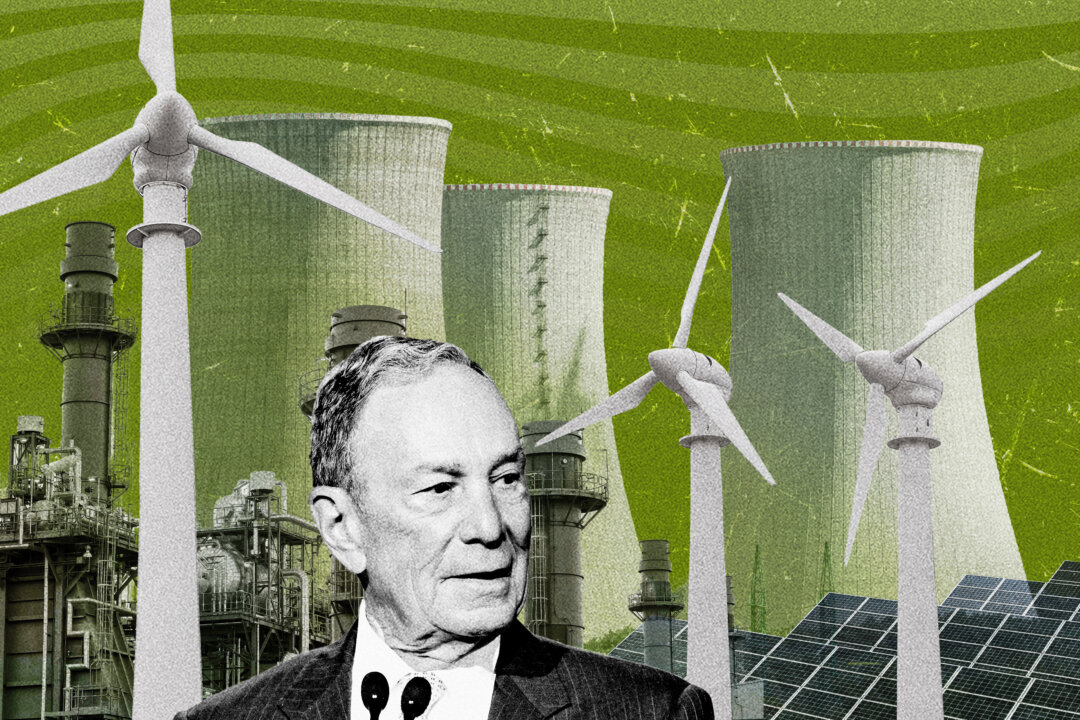
 www.theepochtimes.com
www.theepochtimes.com
Well....shit. Looks like things are going to get worse before they get better.

Behind a $500 Million Donation to ‘Finish the Job on Coal’
Many wind and solar advocates argue that shutting down coal and gas plants is worth the risk and the cost because it'll stop global warming.
Many wind and solar advocates argue that shutting down coal and gas plants is worth the risk and the cost because it'll stop global warming.
Billionaire philanthropist and former New York Mayor Michael Bloomberg pledged $500 million in September toward shifting electricity production in the United States to wind and solar energy and shutting down its coal- and gas-fired plants.
However, some experts say that Bloomberg's millions, together with the billions being spent by the Biden administration, are paving a road to ruin.
The donation from Bloomberg Philanthropies, which adds to the $500 million Mr. Bloomberg pledged in 2019, aims to "finish the job on coal" and "accelerate the clean energy transition to reach the goal of 80 percent of total electricity generation" from renewables, according to an official statement.
"With 372 of 530 coal plants announced to retire or closed to date—more than 70 percent of the country's coal fleet—this next phase will shut down every last U.S. coal plant," Bloomberg Philanthropies stated.
The effort also aims to "slash gas plant capacity in half, and block all new gas plants."
Many of those who study America's electric infrastructure say this is taking us down a dangerous path.

Then-Democratic presidential candidate and former New York City Mayor Mike Bloomberg waits to be introduced during a campaign rally held at Minglewood Hall in Memphis, Tenn., on Feb. 28, 2020. (Joe Raedle/Getty Images)
"We're following people here that are pied pipers," physicist and energy analyst John Droz told The Epoch Times, referring to the literary character who led children to their doom through delusive enticement.
"This whole business of promoting renewables as a solution is completely unproven, scientifically."
The transition is destabilizing America's power grid, which could damage transformers and cause long-term outages, according to Steven Milloy, energy expert, news commentator, and publisher of Junkscience.com.
"We are in this nonsensical, headlong rush to wreck our grid," he told The Epoch Times.
What's overlooked in this drive to close coal and gas plants is America's ability to keep the lights on. And while neither the Biden administration nor Mr. Bloomberg has produced a cost-benefit analysis for their plans, analysts say we can look to places such as Germany and Texas, which have taken the lead in transitioning to wind and solar, for a preview of what's in store.
German energy economist Lars Schernikau has assessed the results of his country's "Energiewende" (energy transition) and warns Americans to not follow Germany's example.
"Wind and solar do not seem to work; otherwise, after 20 years of 'Energiewende,' power prices would be lower and Germany would not be in trouble," he told The Epoch Times.
Germany spent hundreds of billions of euros to build wind and solar facilities since 2002, doubling its power generation capacity and boosting the share of renewables to 60 percent from about 10 percent. However, its electricity production has been flat, while the cost of electricity skyrocketed.
Wind and solar don't increase output proportionately because of their significantly lower "capacity factor," or the percentage that's actually generated versus capacity built.
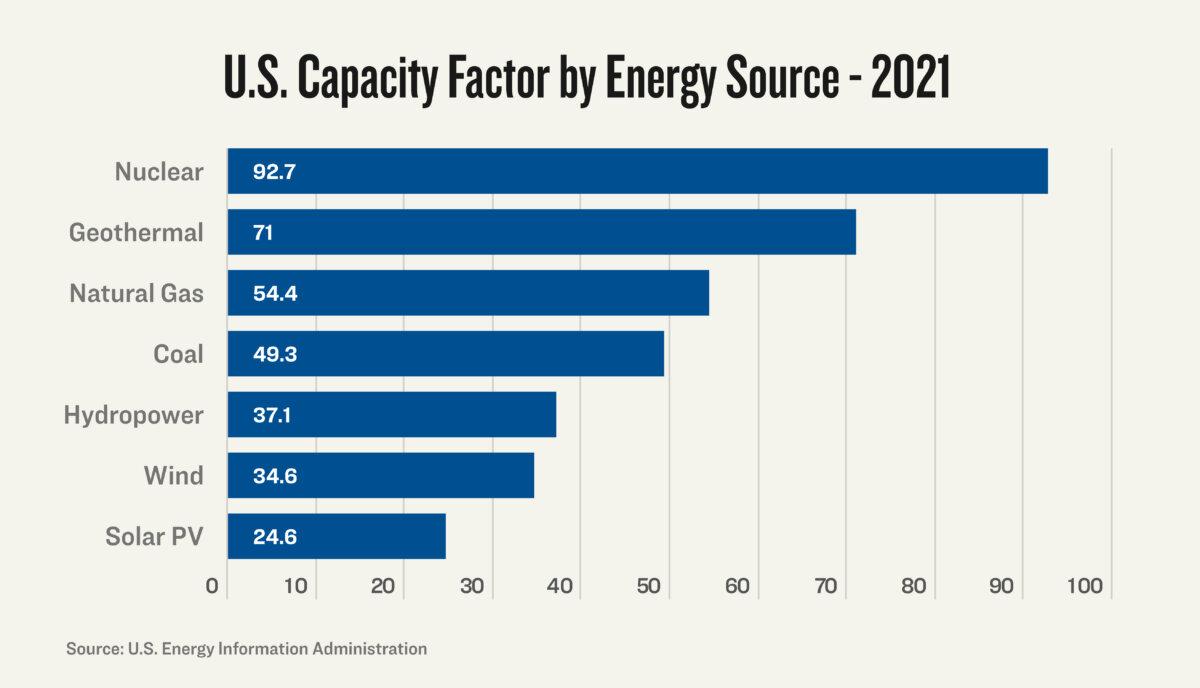
The capacity factor for wind and solar is significantly lower than that for nuclear or fossil fuels. (Energy Information Administration)
The capacity factor for wind and solar is about 35 percent and 25 percent, respectively, compared to roughly 92 percent for nuclear and 50 percent for coal and natural gas. That many utilities prioritize buying power from wind and solar facilities rather than from coal and gas plants artificially inflates the capacity factor for wind and solar, even from these low levels.
However, the results experienced in Germany by wind and solar plants were even worse, Mr. Schernikau stated.
"The natural capacity factor for onshore wind and solar in Germany is on average about 10 percent and about 25 percent, respectively, compared to over 95 percent natural capacity factor for nuclear, coal, and gas," he said.
"However, they have a 'net load factor' of only about 92 percent for nuclear and 50 percent for coal and natural gas, often even lower, driven by the low utilization," Mr. Schernikau said. "That many utilities prioritize buying power from wind and solar facilities rather than from coal and gas plants artificially inflates the relative 'net load factor' for wind and solar, even from these low levels."
For all the billions spent, Germany's "Energiewende" has delivered an increasingly unreliable electric system at a cost to consumers that's higher than virtually every other developed country.
The process of shuttering coal and nuclear plants has left the country at the whim of the weather and unfriendly neighbors, such as Russia, and also dangerously short of dependable power that can be adjusted to meet fluctuations in demand.
People line up for ice cream at Glens Custard in the shadow of the GenOns Cheswick Power Station, which still burns coal to produce 637 megawatts of electricity for the region, in Cheswick, Pa., on June 7, 2021. (Jeff Swensen/Getty Images)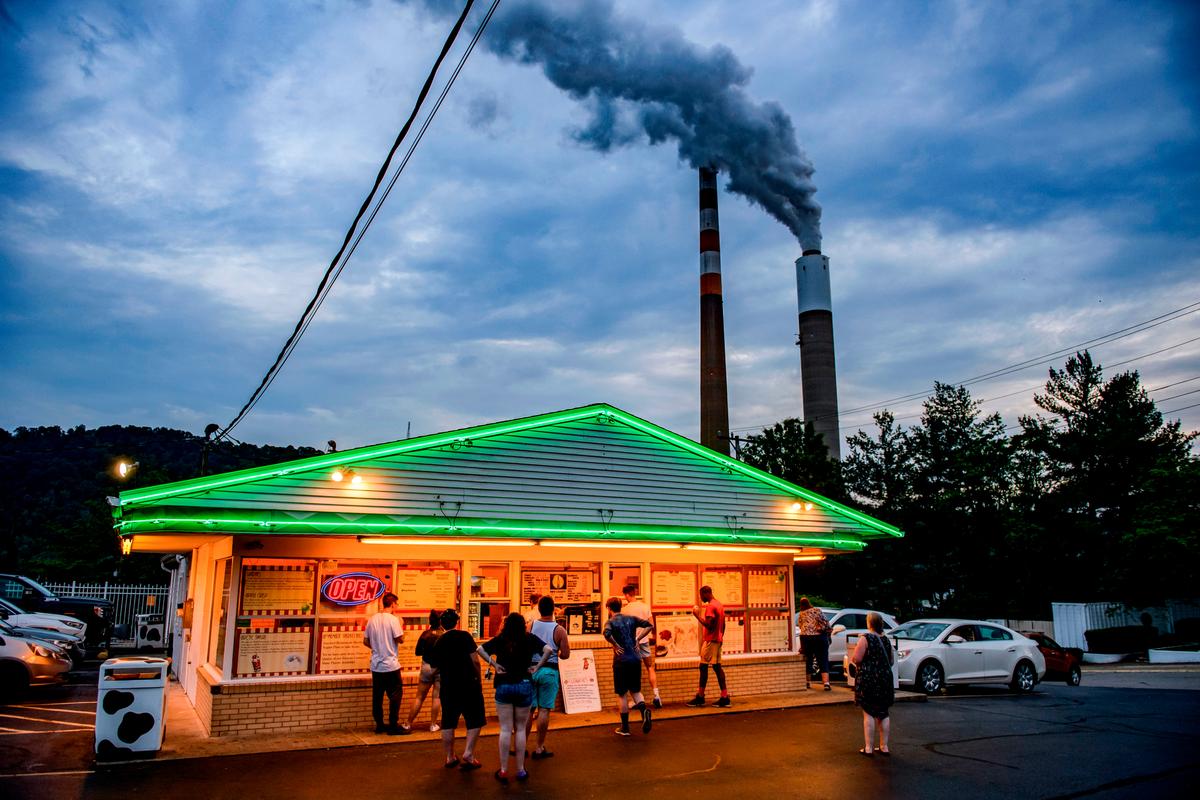
Before the current trend of closing coal plants, electric utilities in the West typically ran their power generation systems with a 20 percent installed reserve margin over expected peak demand, to ensure that they could always meet consumers' needs.
That margin ensured that the electric grid would still function even during unpredicted events, such as a winter freeze in Texas or a summer heat wave in California.
Depleting Reserves to Balance Renewables
The transition to renewables is now eroding that safety margin. Germany, where peak demand is around 80 gigawatts, once had about 100 gigawatts of reliable, dispatchable capacity; now, reliable capacity is down to less than 90 gigawatts, according to Mr. Schernikau.
"That means they are actually at the margin," he said. "As soon as you get close to the margin, whether your reliable power supply equals or is barely above your peak power demand, you're running into trouble, which is exactly what Texas has done."
Electric utilities in the United States, one by one, are following in Germany's footsteps, and we're already seeing similar results. The U.S. Energy Information Administration reported that coal and natural gas plants will account for 98 percent of plant closures in 2023 and that U.S. utilities have halted an average of 11 gigawatts of coal-fired capacity per year since 2015.
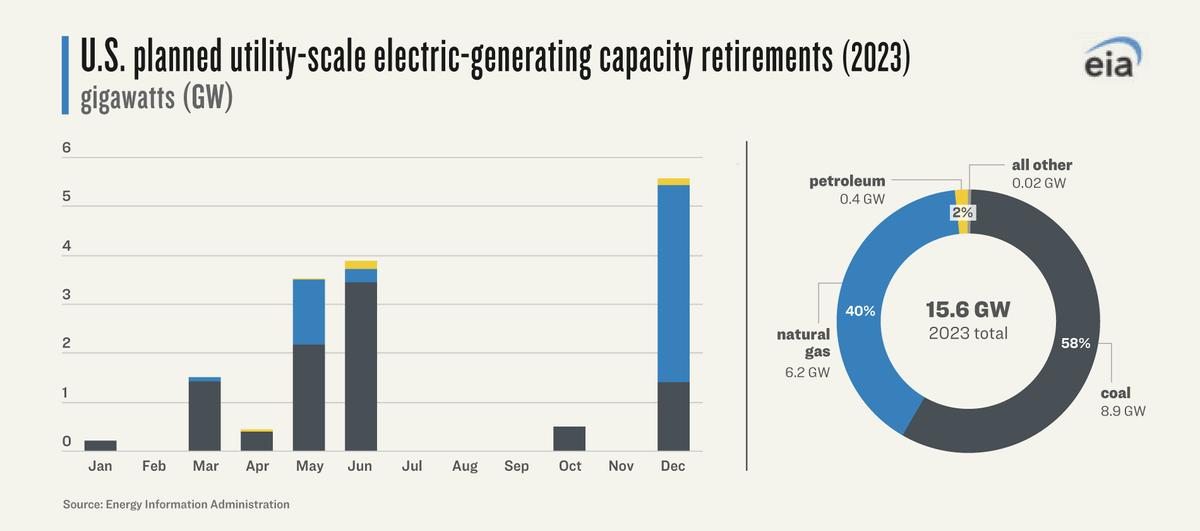
Utilities are rapidly shutting down coal and gas plants. (Energy Information Administration)
The problem for the electric grid as a whole is that the electricity supply must always match the demand. If the system goes out of equilibrium, substantial damage to the grid's hardware could result, leading to long-term outages.
"Wind comes and goes, and you can't operate off of something that's an unpredictable source; you need an auxiliary source of power to balance it out," Mr. Droz said. "Something like 99 percent of that balancing power is gas.
"When these people say wind, that is deceptive because there is no such thing as wind by itself. What they should be saying is a wind-plus-gas package."
What many U.S. utilities are doing is expanding their wind and solar capacity but not adding reliable backup facilities to match it, he said. Instead, the utilities "just dump any excess need for balancing onto the system," hoping that they can draw on other regions when there's a shortfall.
Increasingly, they're also drawing on the emergency reserve.
"The wind developers are using the reserve as the auxiliary, and that's not supposed to be what happens," Mr. Droz said. "They should not be allowed to take from the emergency reserve to balance their wind projects."
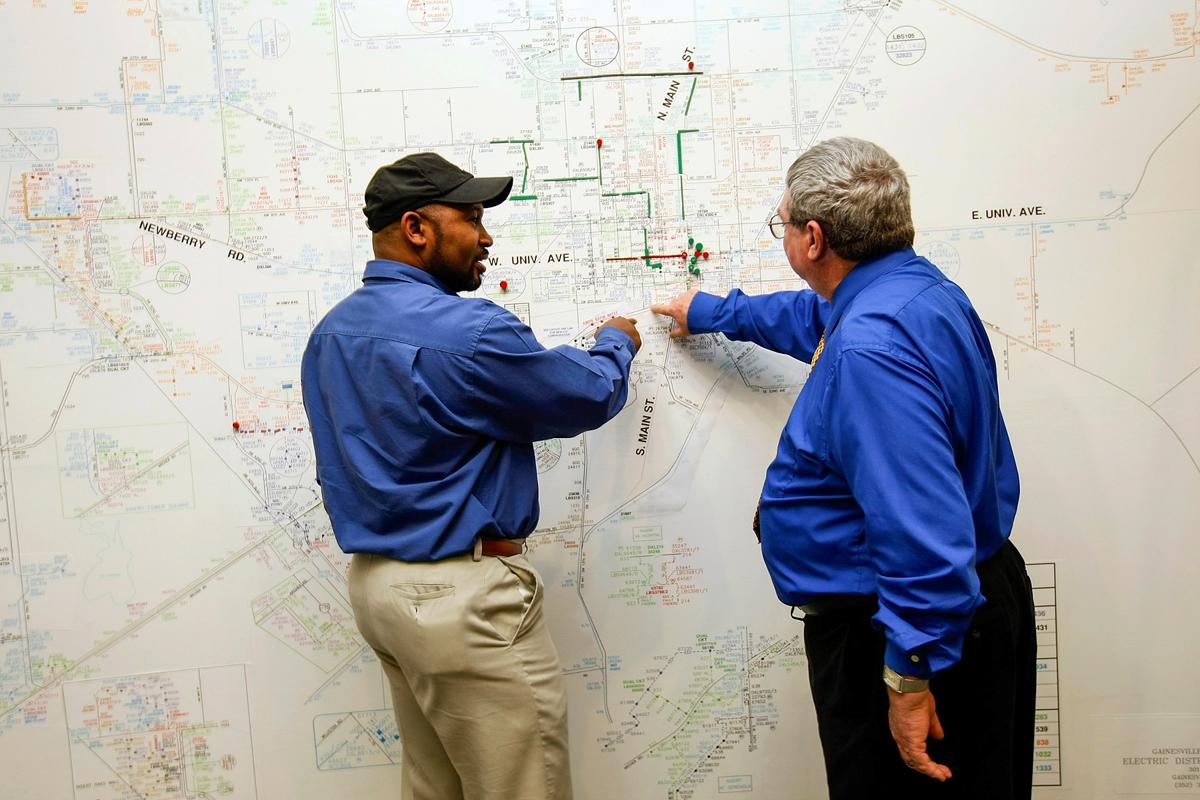
Workers at Gainesville Regional Utilities pinpoint a solar panel installation on the city's electrical grid map, in Gainesville, Fla., on April 15, 2009. That year, the city of Gainesville became the first city in the nation to have a solar feed-in tariff ordinance, allowing owners of solar photovoltaic systems to receive 32 cents per kilowatt hour of electricity produced by the system over the next 20 years. (Joe Raedle/Getty Images)
'Reliability Chicken'
Brent Bennett, policy director at the Texas Public Policy Foundation, refers to this process as "reliability chicken."
"They're having to play a lot of games now in order to justify building more wind and solar," he told The Epoch Times.
Among the utilities, Mr. Bennett said, "everybody is pointing at each other and saying, 'We're going to get energy back from these guys,' and these guys over here say, 'We're going to get energy back from those guys.'"
As long as there's only a small percentage of wind and solar in the system, "they can get away with that," according to Mr. Droz.
"But when you get a more severe case, like the Texas freeze, all of a sudden that reserve that was built in for emergencies is completely gone," he said.
Texas's winter storm Uri in 2021 caused hundreds of deaths, many from hypothermia, when power outages prevented Texans from heating their homes. In that case, utilities in the state came within minutes of collapsing the grid for weeks or longer.
Ultimately, Texas electricity operators were able to implement emergency rolling blackouts and shed enough load to rebalance the system in time to prevent an even greater catastrophe. However, experts warn that operating so close to the margin is a very dangerous game to play.
Testifying before the U.S. Senate in 2015, former CIA Director James Woolsey was asked what would happen to Americans if the electric grid went down for an extended period.
"There are essentially two estimates on how many people would die from hunger, from starvation, from lack of water, and from social disruption," he said.
"One estimate is that within a year or so, two-thirds of the United States population would die. The other estimate is that within a year or so, 90 percent of the U.S. population would die."
Despite that risk, government policies are pushing utilities to move faster to shut down coal and gas plants.
"All the incentives are for utilities to build more wind and solar," Mr. Bennett said.
Among these are the incentives in the Inflation Reduction Act that provide nearly $400 billion in grants, loans, and investment tax credits to build facilities and production tax credits to subsidize the energy they produce. On top of that are state laws that, in many cases, compel utilities to prioritize the purchase of wind and solar output over coal and gas.
New Environmental Protection Agency (EPA) rules mandate carbon dioxide (CO2) emissions limits and carbon capture requirements that will, in sum, force utilities to transition away from coal and gas.
"President Biden has set an ambitious U.S. goal of achieving a carbon pollution-free power sector by 2035 and net zero emissions economy by no later than 2050," the White House announced in April.
"As a result of the historic investments in the Inflation Reduction Act and Bipartisan Infrastructure Law as well as other actions the Administration is taking, the United States is on a clear path to achieve this goal, while reducing costs for consumers, lowering harmful pollutants, mitigating climate change, and creating new economic opportunities."
However, a recent report by the North American Energy Regulatory Corp. (NERC), which monitors America's grid reliability, has warned about large segments of U.S. electricity infrastructure becoming unstable because of a too-rapid retirement of dispatchable fossil fuel plants.
John Moura, director of reliability assessment at the NERC, described the situation in a January interview with The Epoch Times as "running while we're tying our shoes."
Despite the risks, which now even federal regulators are highlighting, "you have the EPA coming out and saying, 'You're not moving fast enough, you've got to move faster,'" according to Mr. Bennett.
Amid promises that wind and solar generation will reduce energy costs, many studies predict the opposite.
Skyrocketing Costs
"The transformation of the global economy needed to achieve net-zero emissions by 2050 would be universal and significant, requiring $9.2 trillion in annual average spending on physical assets, $3.5 trillion more than today," the management consultancy McKinsey stated in a 2022 study.
As the transition to renewables accelerates, consumers continue to see their electric bills rise.
As one U.S. regional utility, North Carolina-based Duke Energy, set in motion its plan to retire coal plants and build out a renewable infrastructure, utility bills quickly jumped by 20 percent.
Wyoming residents have gathered at public meetings in recent weeks to protest a 29 percent boost in their electric bills, as their utility, Rocky Mountain Power, also transitions to renewables.
The state, which is one of America's top coal producers, saw the share of coal-plant production drop in 2022 to 71 percent of its electricity generation from 97 percent. At the same time, the share of wind power rose to 22 percent, making up most of the difference.
Rocky Mountain Power claims that the price increases are because of higher coal and gas prices. Similarly, Texas's Southwestern Electric Power Co. (SWEPCO) also cited rising coal prices for its decision to shutter the Pirkey coal plant before the end of its useful life.
A pedestrian walks by a Pacific Gas & Electric electrical substation in Petaluma, Calif., on Jan. 26, 2022. The Department of Homeland Security has warned that domestic extremists have been developing specific plans to target electrical infrastructure in the United States. (Justin Sullivan/Getty Images)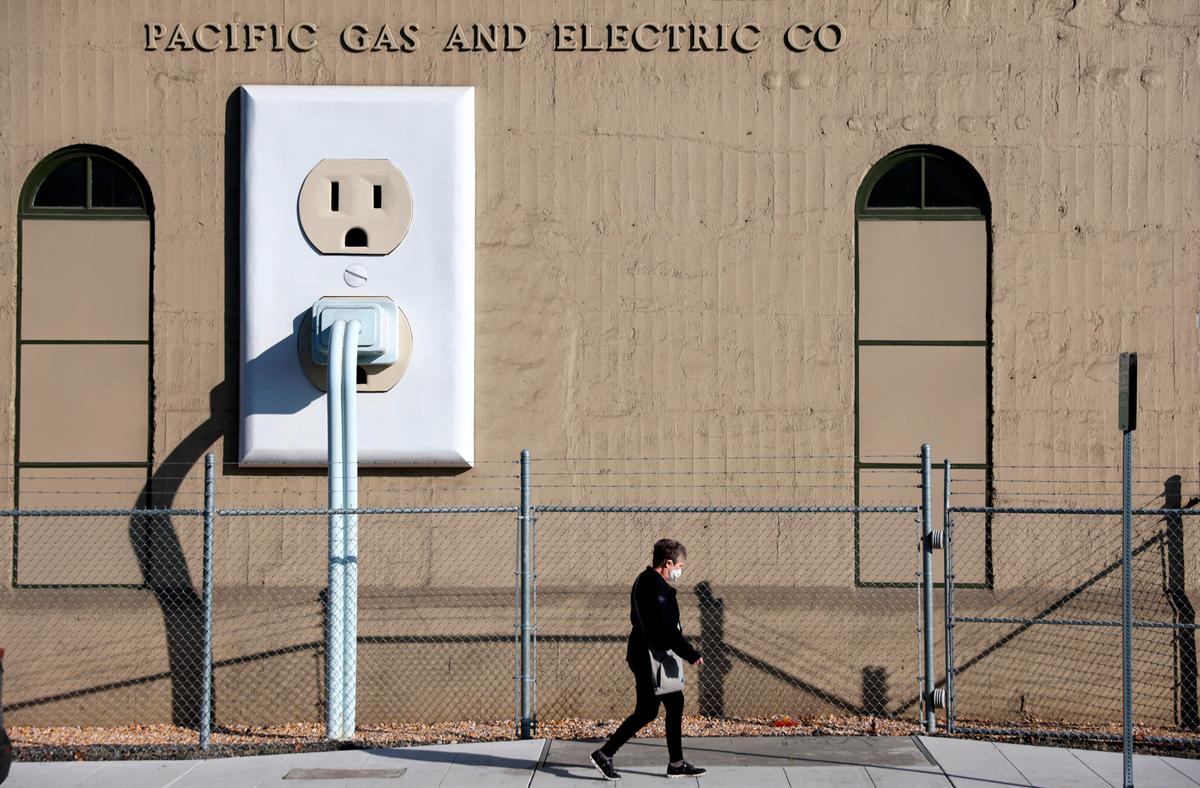
Explaining a Plant Closure
"The ongoing operating costs and the high cost of lignite [coal] were the primary reasons for retiring the plant," SWEPCO spokesman Scott Blake told The Epoch Times.
"Pirkey's fuel costs have been rising for more than 15 years and were expected to remain higher than other similar SWEPCO plants.
"The analysis that led to the decision in 2020 to retire the Pirkey plant showed that avoiding compliance costs and higher ongoing operating and fuel costs would save customers an estimated $740 million to $1.2 billion."
Texas currently leads the United States in transitioning to renewables, with wind and solar increasing to today's combined 45 percent of generation from virtually nil in 2008. As Texas shutters coal plants, it has been replacing them almost exclusively with wind and solar.
Utilities argue that, because the marginal costs of producing wind and solar are lower than that for oil and gas, electricity will become cheaper. However, critics are skeptical that consumers will ever see any savings.
In addition to the cost of a duplicative generation system, there's also the cost of building a massive transmission network to connect urban areas where the electricity demand is concentrated from remote locations where it's windy or sunny.
These costs are often passed on to consumers in the form of higher energy bills.
"Wind and solar will, at grid scale, increase the total system cost, which is the only thing that's relevant to a country," Mr. Schernikau said.
"You don't care about the marginal cost of a kilowatt-hour, you care about the total system cost, and the total system cost always goes up the more wind and solar you have in the system."
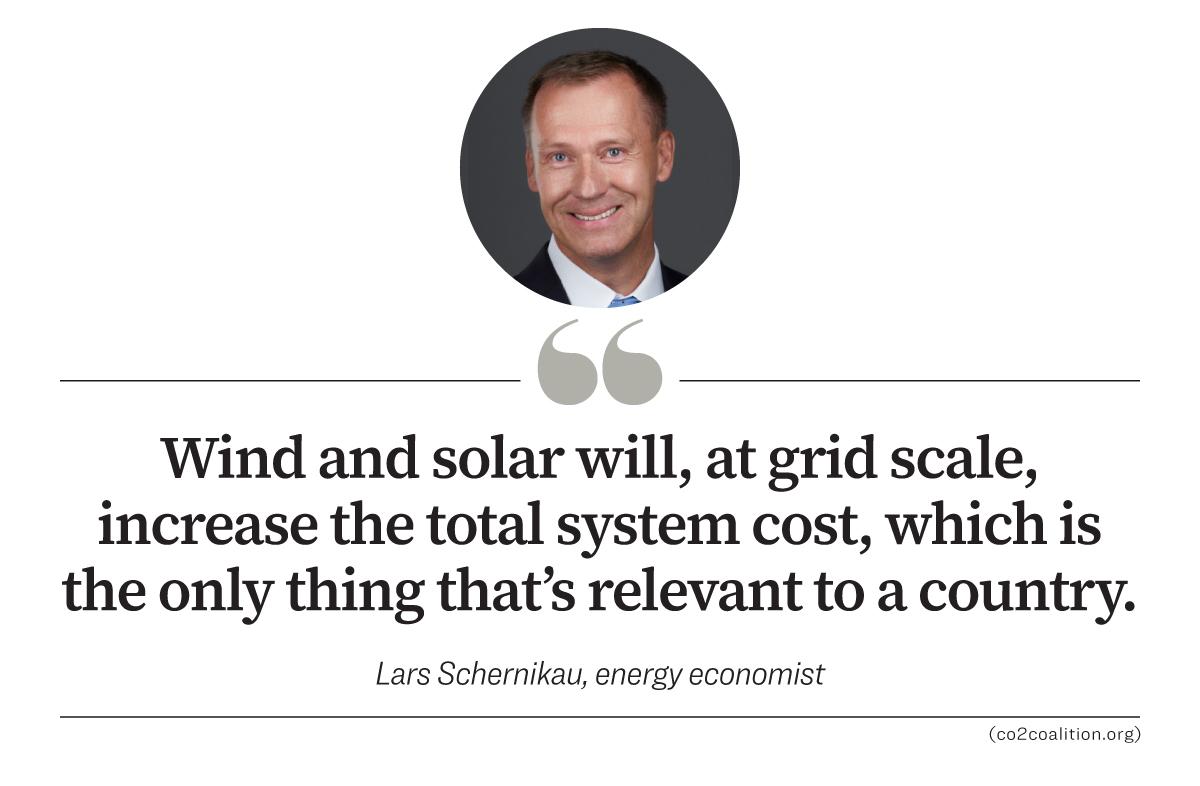
Wind and solar advocates also claim that building battery storage systems will solve that problem, eliminating the need for backup generation systems, which is disputed by many analysts.
"The cost to store energy in grid-scale batteries is about 200-fold more than the cost to store natural gas to generate electricity when it is needed," reads a report by Mark Mills, a senior fellow at the Manhattan Institute.
He said that "$200,000 worth of Tesla batteries, which collectively weigh over 20,000 pounds, are needed to store the energy equivalent of one barrel of oil."
"Even a 200 percent improvement in underlying battery economies and technology won't close such a gap," Mr. Mills said.
]
Industries Leaving Germany
Higher electricity prices aren't just affecting consumers. They're also affecting companies, driving up production costs and making them less competitive.
As a result of Germany's Energiewende, many manufacturing companies are relocating facilities to Asia, according to Mr. Schernikau.
"Heavy industry is leaving the country," he said. "I'm speaking to industrialists and family businesses, who say, 'I have to look at alternatives; the cost of power is too high and the reliability is decreasing; you cannot run industrial organizations like this.'"
Many wind and solar advocates argue that shutting down coal and gas plants is worth the risk and the cost because it'll stop global warming. However, achieving that goal appears unlikely.
Since 2006, the United States has reduced its CO2 emissions to 5 billion tons per year in 2022, or about the same level as 1979, from about 6 billion.
Meanwhile, China nearly doubled its CO2 emissions to 11.5 billion tons from 6.5 billion over the same period and has announced plans for 100 new coal-fired plants in the coming years.
India also doubled its CO2 emissions during this time, to a current level of 2.5 billion tons.
While the West's success in reducing emissions is overwhelmed by the rapid growth in developing countries, also not taken into account in green accounting are CO2 emissions from mining and producing wind turbines and solar panels.
Nor is there an accounting for the environmental damage from using often pristine land and seascapes to install and operate wind turbines and solar panels.

Workers prepare to pour ductile iron casting molten iron into a mould at the Siempelkamp Giesserei foundry in Krefeld, Germany, on April 21, 2022. The company has faced multifold price increases for its raw materials, including scrap iron, nickel, and aluminum, due to EU sanctions against Russia. A company spokesman said that a disruption to Germany's natural gas supply would bring much of the foundry's manufacturing ability to a halt. (Sascha Schuermann/Getty Images)
"Power plants and transmission lines will be located in areas not accustomed to industrial development, potentially creating opposition," a report by the left-leaning think tank Brookings Institution reads.
"Wind and solar generation require at least 10 times as much land per unit of power produced than coal or natural gas-fired power plants, including land disturbed to produce and transport the fossil fuels."
Retreat from Net-Zero Mandates
Germany was forced to restart or delay the closure of about 20 coal-fired plants last year because of the failure of wind and solar to deliver reliable energy, coupled with a boycott of natural gas supplies from Russia,
That's part of what appears at the moment to be a multifaceted retreat from net-zero mandates across Europe, which also includes delaying bans on internal combustion engines and gas stoves.
The share of wind and solar in total energy consumption in Germany is only about 5 percent, indicating a continuing demand for fossil fuels. Despite all government efforts throughout Europe to shift to renewables, fossil fuels still represent 70 percent of total energy consumption there.
Worldwide, fossil fuels make up 80 percent of energy consumption, and countries such as China and India are investing heavily in new coal-fired power plants.
"For me, it's not political, it's just pure logic, economically and environmentally, what is the right thing to do," Mr. Schernikau said. "And unfortunately wind and solar are not the right thing to do at grid scale.
"It doesn't mean every windmill is bad; it doesn't mean every solar panel is bad. But if you try to replace the system with this, you are running into trouble, and Germany is a perfect example."
As Europe rethinks its transition to renewables and Asia charges forward with building its coal capacity, the United States is accelerating its dependence on wind and solar generation.
"We are in a very scary place," Mr. Milloy said. "We are headed towards a brick wall and there is nobody doing anything about it."
Well....shit. Looks like things are going to get worse before they get better.
mrttao
Well-known member

American lawyer shoots dead two climate protesters blocking traffic in Panama after weeks of protests that have shuttered schools, businesses
Guys, I'm not endorsing this, but we have ourselves here a predictable case of the found outs.
Fucking finally.
Terthna
Professional Lurker
These people don't know anything; they're morons with "prestigious" degrees who think they're playing a game of SimCity.
DarthOne
☦️
These people don't know anything; they're morons with "prestigious" degrees who think they're playing a game of SimCity.
Unfortunately true. And even more unfortunately, a very widespread malady.
They still would win and send us to green lgbt gulags,if we do not act.These people don't know anything; they're morons with "prestigious" degrees who think they're playing a game of SimCity.
And,we would be remembered as dudes who let morons genocide them.
Biden Hands Out $2B in Taxpayer $$$ to Political Allies for ‘Climate Justice’ in 2024
DarthOne
☦️
Biden Hands Out $2B in Taxpayer $$$ to Political Allies for 'Climate Justice' in 2024

 www.frontpagemag.com
www.frontpagemag.com

Biden Hands Out $2B in Taxpayer $$$ to Political Allies for 'Climate Justice' in 2024 | Frontpage Mag
If you want to get your money, make sure Biden wins.
Media outlets often ask, "who funds conservative group x". They never seem to ask who funds lefty groups. But beyond the usual mega-donors, Ford Foundation, George Soros, and Fortune 500 companies, there's an even grimmer answer: the government does.
Taxpayer money diverted to lefty political organizations is still the biggest source of funding for the Left. And the thievery is only becoming more blatant.
"Today, the Biden-Harris administration announced approximately $2 billion in funding available to support community-driven projects that deploy clean energy, strengthen climate resilience, and build capacity for communities to tackle environmental and climate justice challenges. The U.S. Environmental Protection Agency's (EPA's) Community Change Grants are the single largest investment in environmental justice going directly to communities in history, and will advance collaborative efforts to achieve a healthier, safer, and more prosperous future for all. These funds, part of President Biden's Investing in America agenda, are made possible by the President's Inflation Reduction Act—the biggest-ever investment in clean energy and climate action."
Let's translate that into English. Minority community groups linked to the Democrat Party will be showered with taxpayer money on the condition that the right guy wins in 2024.
This corrupt arrangement will be paid for by taxpayers making it twice as corrupt.
The Community Change Grants deliver on President Biden's historic commitment to advance equity and justice, including his Justice40 Initiative. The Community Change Grants will deliver 100 percent of the benefits of this program to disadvantaged communities that are marginalized by underinvestment and overburdened by pollution.
East Palestine need not apply, but a whole lot of that money will go to Detroit and Cook County.
What do you need to do to get hold of a piece of that $2 billion pie?
Your community group needs to engage in "climate resiliency and adaptation", that means encouraging people to paint their houses white or get better insulation, "mitigating climate and health risks from urban heat islands, extreme heat, wood heater emissions, and wildfire events", that means installing air conditioners in their facilities, and "facilitating the engagement of disadvantaged communities in state and federal advisory groups, workshops, rulemakings, and other public processes" or in other words, community organizing.
But here's the kicker.
"The NOFO will be open for a year, closing on November 21, 2024"
That's interesting timing. There could hardly be a more explicit way of saying, if you want to get your money, make sure Biden wins.
Last edited:
Coming Soon: Your Travel Will Be Restricted By Personal Carbon Allowances
DarthOne
☦️
Coming Soon: Your Travel Will Be Restricted By Personal Carbon Allowances

 bombthrower.com
bombthrower.com
From a comment
That said, remember this: The American Revolutionary War was fought with only about 3% of the population. And nobody can comply hard enough to win back freedom.

Coming Soon: Your Travel Will Be Restricted By Personal Carbon Allowances
personal carbon allowances” that will restrict how often one is permitted travel.
"Experts suggest" your standard of living be reduced by over 85%
A report on the future of travel and tourism, co-authored by a travel agency called Intrepid Travel and The Future Labs Institute, posits a future deeply impacted by climate change and restrictions on tourist travel to combat it.
"A Sustainable Future for Travel", warns of "travel extinction", where some areas suffer such radical climate change that all tourism there ceases, and "personal carbon allowances" that will restrict how often one is permitted travel.
From the report (pardon the length, emphasis added):
"Carbon Passports"
A personal carbon emissions limit will become the new normal as policy and people's values drive an era of great change.
As demonstrated by a worldwide tourism boom, the frequency at which we can fly is once again seemingly unlimited.
Conscience and budgets permitting, we feel free to hop on planes from one place to the next. But this will change. 'On our current trajectory, we can expect a pushback against the frequency with which individuals can travel, with carbon passports set to change the tourism landscape,' says Raymond [Martin Raymond, Future Laboratories co-founder]
Personal carbon allowances could help curb carbon emissions and lower travel's overall footprint.
These allowances will manifest as passports that force people to ration their carbon in line with the global carbon budget, which is 750bn tonnes until 2050.
By 2040, we can expect to see limitations imposed on the amount of travel that is permitted each year.
Experts suggest that individuals should currently limit their carbon emissions to 2.3 tonnes each year – the equivalent of taking a round-trip from Rio de Janeiro, Brazil, to Riyadh, Saudi Arabia. However, the average carbon footprint in the US is 16 tonnes per person per year, 15 tonnes in Australia and 11.7 tonnes in the UK. This is in stark contrast to where we may find ourselves in the future, with 2040's travellers forced to forgo the horizon-expanding experiences so readily embraced by today's tourists"
For all practical purposes, your carbon emissions will line up with your energy usage, give or take a relatively narrow band of efficiencies (unless we have some kind of clean energy breakthrough, and the only viable one we have, nuclear, is not considered clean energy by the climate cult).
Said differently: Your standard of living is your energy usage. Reducing a society's energy usage is the same as reducing its living standards.
With this in mind, let's look at the numbers cited by the Sustainable Future for Travel report:
"Experts suggest that individuals should currently limit their carbon emissions to 2.3 tonnes each year."
The table below lays out exactly how much the standard of living for the residents of each country will have to be reduced in order to meet the recommended carbon quota set by unelected experts. This is the level of "degrowth" it will take to satisfy the objectives of climate alarmists relying on unfalsifiable premises, arbitrary computer models, and who are deliberately ignoring and suppressing countervailing data.

How serious are our leaders and policymakers about reducing the citizenry's living standards by upwards of 85%?
Here is Canada's Environment Minister Steven Guilbeault, rather blithely confirming that the government will limit natural gas usage in order to fight climate change:
Reporter: There will be limitations on how much natural gas you can use in the winter?
Guilbeault: Yes, absolutely, that's what fighting climate change looks like.
Full clip:
Why are we talking about carbon passports in the section on Central Bank Digital Currencies?
(Today's post is an excerpt from the "Eye on Evilcoin" section of this month's Bitcoin Capitalist macro overview).
Because we think CBDCs will invariably launch as, or morph into, personal carbon footprint quotas.
Right now, what we call "the fiat money system" uses debt for money. That's no longer sustainable, so what we're expecting is an attempt to switch what we loosely identify as "money", away from symbolic tokens backed by debt, to social credit scores, backed by personal carbon footprint quotas.
In the future, what we loosely identify as 'money' will switch from being symbolic tokens backed by debt, to social credit scores, backed by personal carbon footprint quotas.
Expanding on this theme, probably, is another report from Future Labs on "Neo-Collectivism", which may give us a hint at how the policymakers of late stage globalism will seek to preempt free markets and universal human rights with a "we're all in this together" retread of what is essentially, communism:

"Society is facing a mass re-organisation. United by values of empathy and community, consumers are shunning individualism in favour of alliances that are decentralising industries and redistributing power at scale"
LS:N Global and Future Laboratories seem like a wannabe World Economic Forum. Lots of pronouns on the "Team" page, and leaning heavily into that euphemistic WEF-speak that makes technocratic communism sound benign and fashionable
I ended up shelling out £265 to by the Neo-Collectivist Megatrend report (a 40 page PDF) and what I found in there was along the lines of what one might expect, but it was alarming all the same.
In the next post to this one, we'll dive into it and find out just how the "Zalpha Generation" is poised to usher us into an era of Systemic Endemic Socialism.
My forthcoming ebook The CBDC Survival Guide will give you the tools and the knowledge to navigate coming era of Monetary Apartheid. Bombthrower subscribers will get free when it drops, sign up today.
If you're curious about The Bitcoin Capitalist Letter I will be closing it off to new subscribers soon. I explain why to Bombthrower subscribers.
From a comment
They won't have to kill you. They locked you down and most of you complied
They told you to wear masks and most of you complied. They told you to take a dangerous untested jab and even most Republicans complied..
And let's not forget that all the FBI had to do was give you a angry look after January 6th and most of you were too scared to ever protest again
So when they tell you that your air travel is going to be limited And it's linked to your passport so they'll be able to keep track of how much carbon you've emitted most of you will comply. Many of you won't have a choice and most of you won't be bothered to try to find ways around it. You'll just accept it as a new part of life like you did for the lockdowns like you did for the mask mandates like you did for the vaccine passport to go to concerts and movies and fly on airplanes
Republicans are big talk about "defending their freedoms" and being "patriots" but when it really comes down to it they're a bunch of compliant pussies
Antifa and BLM did more to fight for what they believed in than conservatives ever
And it will probably stay that way because the type of people to become left-wing are activist people that want to make changes and the type of people who become right-wing are lazy people who don't like change.. And so they typically support the status quo. No matter what that status quo is. And if the status quo changes they support the new status quo.. Because of their fear of change and laziness
That said, remember this: The American Revolutionary War was fought with only about 3% of the population. And nobody can comply hard enough to win back freedom.
Munich Airport in Germany was paralyzed by a snowstorm that grounded all flights.
Apparently that also included private jet flights preparing to fly to a climate change summit in Dubai.
 www.zerohedge.com
www.zerohedge.com
Just terrible...
Apparently that also included private jet flights preparing to fly to a climate change summit in Dubai.
Private Jets Headed To Global Warming Conference "Literally Frozen On Runway" | ZeroHedge
ZeroHedge - On a long enough timeline, the survival rate for everyone drops to zero
Just terrible...
Massachusetts Solar Power Hits a Wall
DarthOne
☦️
Massachusetts Solar Power Hits a Wall
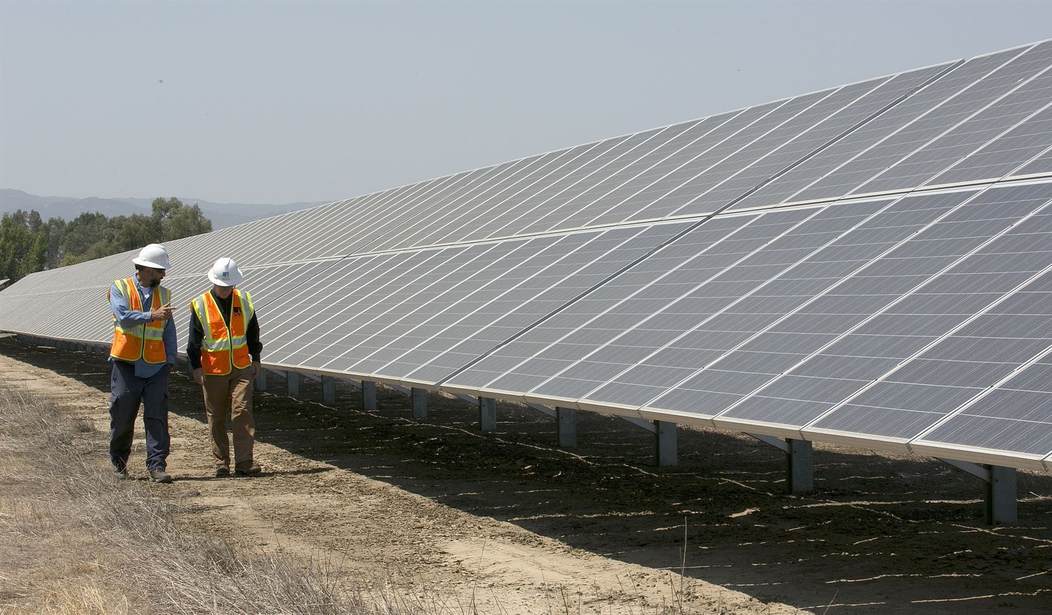
 hotair.com
hotair.com

Massachusetts Solar Power Hits a Wall
Like many blue states, Massachusetts was an early adopter of the solar power craze, pushing through government subsidies to spur development and setting up solar panels everywhere they could be jammed...
Like many blue states, Massachusetts was an early adopter of the solar power craze, pushing through government subsidies to spur development and setting up solar panels everywhere they could be jammed into place. But now the solar wave is slowing to a crawl, making the state what the Boston Globe describes as "a victim of early success on solar." Hundreds of previously approved projects that were billed as being capable of producing 400 megawatts of energy are sitting idle. And there seems to be a great deal of confusion about what went wrong in the planning stages.
The dairy barn at The Farm School in Athol is home to about a dozen cows, a few small rooms filled with cold tanks and pasteurizing equipment, and, most days, classes of Boston-area middle schoolers learning about work, farming, and being good environmental stewards.
By now, the barn could also have been home to 88 solar panels to help power the farm's operations and offer another lesson for visiting students — one about clean energy, and how everyone has to do their part to address the climate crisis.
But The Farm School has run into a hurdle that's tripping up communities, nonprofits and solar developers across the state: a maxed-out electric grid that's slowing Massachusetts' progress on solar energy to a crawl at the very time that it ought to be soaring.
This isn't a situation where they are short of solar panels or other required equipment. The problem is that the people approving all of these projects don't seem to have known a lot about how the power grid actually works. When you install a new power-generating source of any type, it needs to be hooked up to the grid. (Obviously.) However, each type of power plant has its own unique connection structure. And it's not just a question of how you hook it up, there is also the question of where you can put them. Too many in one area can overwhelm the grid while other areas go without power.
That's what appears to have tripped up the planners in Massachusetts. The negative results have been measurable. Two years ago the state was 11th in the nation for new solar installations. This year they fell to 27th. The Governor currently projects that they will be able to generate six gigawatts of solar energy by 2028. They had originally claimed that they would reach ten gigawatts by then.
It also appears that while solar installations are still being constructed all across the country, the technology hasn't kept up with earlier promises and projections. One of the major hindrances for solar is its "capacity factor." That's a fancy way of describing not only how much power it can produce, but how much of the time it is actually putting out that power and how often it is idle.
Like other renewables that rely on weather, solar is held back by its "capacity factor", essentially how often it is producing electricity. A coal power station runs at 70-80% capacity. In northern Europe, solar panel capacity factor is just 15%. This reduces its competitiveness significantly.
So instead of the continued exponential growth that is modelled by the Oxford team, Qin predicts "moderate growth in solar could continue as seen in recent years, but the growth will flatten out, turning into an S curve".
Coal and oil plants work as long as you have fuel and people to operate them. Solar doesn't work at night and it runs at lower capacity when it's cloudy. Wind turbines don't produce energy if the wind isn't blowing. Also, if it weren't for all of the government subsidies behind these projects (that you generously pay for with your tax dollars), they would be too expensive to reach the break-even point for a very long time and people would steer clear of them. What Massachusetts was really being sold appears to have been a bill of goods.
Bigking321
Well-known member
Yep.
Solar and wind power is stupid when compared to other power sources.
Solar and wind power is stupid when compared to other power sources.
mrttao
Well-known member
They do make for good off the grind installations for those wanting to be free of govt.Yep.
Solar and wind power is stupid when compared to other power sources.
But yea, the focus should have been a nuclear grid
Threadmarks
View all 50 threadmarks
Reader mode
Reader mode
Recent threadmarks
Massachusetts Solar Power Hits a Wall Jane Goodall, advocates reducing the global population down to 450 million—a 95% reduction from today's population Member of the WEF and deputy PM of Canada, Chrystia Freeland, declares war on democracy, in the name of tackling "climate change". Minnesota cities went for EVs in public transit, but the buses couldn't handle the cold Trillions Spent On 'Climate Change' Based On Faulty Temperature Data, Climate Experts Say European Farmers Revolt Poll finds elites want strict rationing of gas, meat, electricity, freedom Mass arrests of Farmers beginUsers who are viewing this thread
Total: 2 (members: 0, guests: 2)
